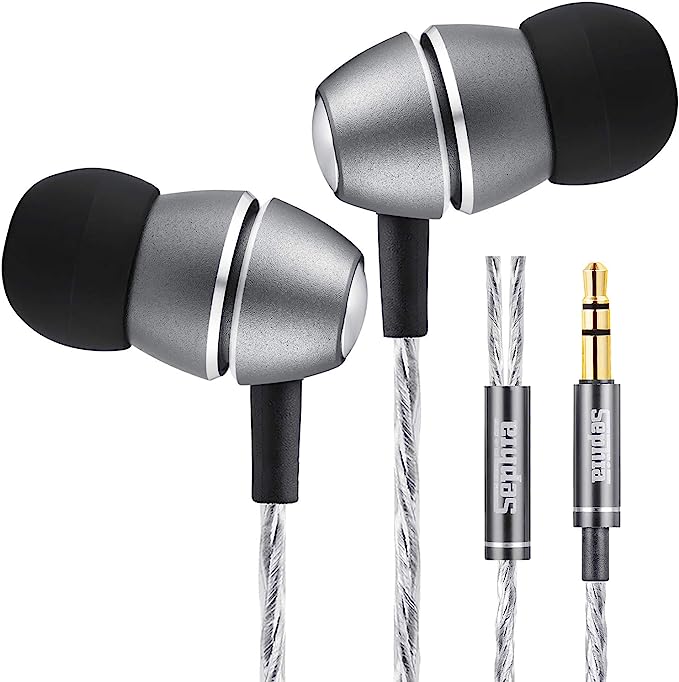YINYOO J6808Y KBEAR Rosefinch in Ear Earphones - Enhanced Sound Quality and Convenient Features
Update on June 25, 2025, 3:08 p.m.
Can a pair of earphones costing less than a couple of movie tickets truly deliver a satisfying, engaging audio experience? It’s a question many music lovers ponder as they navigate a market teeming with options, from ultra-premium to astonishingly affordable. Today, we embark on an auditory detective mission, using the YINYOO J6808Y KBEAR Rosefinch in-ear earphones as our primary specimen. Our goal isn’t just to look at what they offer for their modest $23.99 price tag, but to delve into the fascinating science and engineering principles that can conjure compelling sound from seemingly simple components. Prepare to discover that good sound isn’t always about exorbitant costs; often, it’s about smart science.

The Sonic Soul: Crafting a Voice with Science
The heart of any earphone lies in how it shapes sound, a process deeply rooted in scientific understanding. For the KBEAR Rosefinch, several key elements define its acoustic signature.
First, let’s talk about tuning, and the term “Harman Curve” often surfaces in audio discussions. What is it, beyond a buzzword? Imagine a group of scientists meticulously studying what kind of sound signature most people find pleasing and “natural” in headphones. This research, prominently led by Dr. Sean Olive and his team at Harman International, resulted in the Harman Target Curve. It’s not a rigid law that all audio gear must follow, but rather a research-backed guideline, a sort of “North Star” for a frequency response that resonates well with a broad audience. The science behind it delves into psychoacoustics – the fascinating study of how our brains perceive sound, considering factors like the shape of our ear canals and our inherent preferences for tonal balance. The Rosefinch description states its tuning is “Based on the Harman Curve” but with an “enhanced the atmosphere and quantity of bass.” This deliberate deviation isn’t arbitrary. It’s a conscious engineering choice, likely to cater to listeners who enjoy a more impactful low-end, a characteristic often favored in popular genres like rock, pop, and electronic music, aiming for that “more dynamic and thicker sound signature.”
Next, we peer into the “engine room” – the driver. The Rosefinch employs a “1 dynamic driver” configuration. Think of a dynamic driver as a miniature, high-fidelity loudspeaker working diligently right inside your ear. Its operation is a beautiful dance of physics: an electrical audio signal flows through a voice coil, which is attached to a delicate diaphragm (a thin, movable membrane). This coil sits within a magnetic field. As the electrical current changes with the music, it creates a fluctuating magnetic force, causing the coil and diaphragm to vibrate rapidly. These vibrations push and pull the air, creating the sound waves that our ears interpret as music. Dynamic drivers, due to their design and ability to move a relatively larger volume of air compared to some other driver types at similar sizes, are particularly renowned for their capacity to reproduce robust and extended bass frequencies. This aligns perfectly with the Rosefinch’s stated aim for a sound with substantial low-end authority. This is a fundamental characteristic stemming from the principles of electromagnetism and mechanics.
But having a great driver isn’t enough if your audio source can’t power it properly. This brings us to “low impedance and high sensitivity.” Let’s use an analogy: imagine impedance (measured in Ohms) as how “thirsty” the earphones are for electrical power. Lower impedance means they don’t need a very high voltage from your device to draw sufficient current. Sensitivity, on the other hand, is like how “loud” the earphones get with a given “drink” of power – how efficiently they convert electrical energy into sound pressure (volume). The Rosefinch’s combination of low impedance and high sensitivity is a key engineering feat for a budget-friendly, everyday earphone. It means, as the description proudly states, “Mobile phones can also be easily pushed directly.” You don’t need a bulky, expensive external headphone amplifier to achieve satisfying listening levels. This is basic electrical engineering (think Ohm’s Law and power calculations: P = V²/R or P = I²R) applied thoughtfully to ensure broad compatibility and ease of use with common devices like smartphones, laptops, and PCs.

Beyond the Drivers: The Supporting Cast of Materials and Design
An earphone is more than just its sound-producing core; the materials and physical design play crucial supporting roles in durability, comfort, and even the final sound presentation.
The connection to your device is made via a “Professional 4 core OFC wire.” OFC stands for Oxygen-Free Copper. Copper is an excellent conductor of electricity, making it ideal for audio cables. However, impurities, particularly oxygen, can, over time, lead to oxidation and slightly increased resistance, potentially (though often debated in terms of audibility) degrading the signal. OFC is processed to reduce its oxygen content significantly, aiming to create a “purer” electrical pathway for the audio signal. Think of it as ensuring the “highway” for your music is as clean and unobstructed as possible. While the audible benefits of OFC over standard high-quality copper in short earphone cables are a subject of ongoing discussion among audiophiles, using good quality copper as a baseline is undoubtedly a sound engineering choice. The “4 core” likely refers to the internal structure of the cable, often having separate conductors for the left and right audio channels and their respective grounds, which can contribute to better stereo separation and overall signal integrity.

Perhaps one of the most user-appreciated features at this price point is the “Detachable 2pins 0.78mm Connector.” This isn’t merely a convenience; it’s a significant engineering decision that enhances both longevity and versatility. Cables are often the Achilles’ heel of earphones, prone to wear and tear. A user named Nick d, in the provided reviews, mentioned experiencing wire fragility after some (admittedly rough) use. With a detachable cable, a frayed or broken wire doesn’t mean discarding the entire earphone. You can simply replace the cable, extending the life of your investment. This is a nod to repairability and sustainability. Furthermore, it opens the door to personalization. The audiophile world loves to experiment, and some users enjoy trying different cable materials or constructions, believing they can subtly tweak the sound. This 0.78mm 2-pin standard is common, offering a range of aftermarket options.

Comfort is king for any wearable technology, and earphones are no exception. The Rosefinch boasts an “Ergonomic design and ear Hook.” Our ears are wonderfully complex and unique in shape. Good ergonomic design in earphones involves studying the anatomy of the human ear, particularly the concha and ear canal (the auricle), to create a housing shape that fits snugly and securely without causing pressure points. The “Wrap-around ear design” and “memory ear hook” further enhance this. The memory ear hook is a clever application of material science; these flexible hooks can be shaped around the back of your ear and will largely retain that shape, providing a customized, secure fit. This is invaluable not just for comfort during long listening sessions but also for keeping the earbuds from slipping out during activities like commuting or light exercise.
This secure and comfortable fit, achieved by selecting the correct size from the “3 pairs of silicone ear tips,” is also the secret behind effective Passive Noise Isolation. Unlike Active Noise Cancellation (ANC), which uses sophisticated electronics and microphones to create “anti-noise” to cancel out external sounds, passive isolation is all about physics. By creating a good seal between the eartip and your ear canal, the earphone physically blocks a significant amount of ambient noise. Think of it as closing a window on a busy street; the outside world fades, allowing your music to take center stage. A major benefit of good passive isolation is that you can often enjoy your music at lower, and therefore safer, listening volumes because you’re not constantly battling to hear it over the din of your surroundings.

The Conductor’s Baton: Interface and Interaction
Ease of use and practical features are essential for an everyday audio companion.
The version “with mic” includes an “in-line microphone” that, according to the description, “sits just below the jaw.” This placement is a common and sensible choice based on basic acoustic principles: it’s close enough to the mouth for reasonably clear voice pickup during phone calls. The accompanying “One-button line control” is a simple yet effective electromechanical switch. A press or series of presses completes different circuits, signaling your connected device to perform actions like answering or ending calls, and controlling music playback (play, pause, or skipping tracks). It’s worth noting that the product explicitly states “volume control not supported” via this single button, meaning volume adjustments need to be made on the source device itself.
And finally, the connection to the world: the “3.5mm plug.” This humble, cylindrical connector is an analog audio stalwart. Its widespread, near-universal adoption for decades means it’s compatible with an enormous range of devices, from computers and smartphones (though some newer phones have omitted it) to MP3/MP4 players and many music speakers. Its enduring presence speaks to its simplicity and reliability.

Harmony of Science and Experience: When Design Meets Delight
The proof of good engineering, of course, is in the listening and user experience. The KBEAR Rosefinch has garnered a respectable 4.4 out of 5 stars from 666 global ratings on the provided product page. This positive reception isn’t arbitrary; it generally reflects how the amalgamation of these scientific and design choices translates into real-world satisfaction for many users.
When a user like Alpha from India highlights the “big tight bass” and “still sounds balanced and natural with no harshness,” praising its “dynamics and punch,” this user experience directly echoes the intended outcomes of a dynamic driver tuned with an enhanced bass response based on the Harman philosophy. Similarly, when Gabe Maas states, “The low end is GREAT,” and even prefers them for casual listening over his significantly more expensive Shure 535 earphones, it underscores the remarkable “value for money” that can be achieved through intelligent, cost-effective engineering. Even the occasional critique, like the concern about wire fragility, is somewhat mitigated by the foresight of including a detachable cable system.

Coda: The Democratization of Good Sound – And the Joy of Understanding It
The YINYOO KBEAR Rosefinch earphones serve as a compelling and accessible case study. They demonstrate that thoughtful application of audio science and careful engineering can indeed bring genuinely enjoyable sound to a price point that makes it available to almost everyone. It’s a testament to the democratization of good audio.

But perhaps more importantly, understanding the “why” behind an earphone’s sound – the psychoacoustics that inform its tuning, the mechanical marvel of its drivers, the material science in its cables, and the ergonomic considerations in its fit – enriches the listening experience itself. It transforms listening from a passive act into an active appreciation.
So, the next time you plug in your favorite pair of earphones, whether they’re budget-friendly champions like the Rosefinch or high-end marvels, take a moment. Listen closely, listen critically, but most importantly, listen with the added layer of joy that comes from understanding a little bit more about the beautiful, intricate science of sound.



























































